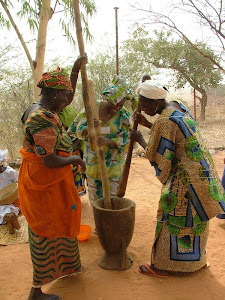My first day at Fandoga Beri was quite interesting and I had
a dim bulb moment. We were told at the
training site we would be receiving a Muslim name from our host family and for
some reason, this slipped my mind. It’s
so strange to be so excited that you would forget you would no longer be called
by your birth name. So two other Peace
Corp trainee’s and myself went to Fandoga Beri and when we arrived we sat
before the Chief and the people of the village.
I had been in the country for two days and could barely speak Zarma, so
I wasn’t sure what was being said other than I felt very welcomed.
When I arrived at my hut I was met by my host Mother, Hisa
and my host sister. I had my Zarma
language cards in my hand to help with basic “How do you do’s?” I quickly understood my host Mothers and
sisters name’s however I couldn’t understand why they didn’t understand that my
name is Meresa. At one point they acted
like it took everything in them not to hysterically laugh. So then I became concerned “What am I
saying?!” I would look back at the
language cards over and over again perplexed wondering what exactly I was
saying, thinking “Maybe Meresa just doesn’t sound right to them, the
combination of the vowels and consonants.”
A Peace Corp Volunteer (PCV) that had been in the country
for one year made her rounds to each of our huts to see how we were doing. She looked around and was surprised that I
had everything already situated…my bed was made, everything was put away and in
its place. I commented “I feel now that
I’m situated there’s no distractions to jump right in. Speaking of which, I think there’s some
miscommunication. I tried telling my
host family my name and they didn’t understand.
If I understand my host Mother is Hisa.”
My fellow PCV went to speak to Hisa and came back. She sat down next to me on my bed, trying not
to laugh and said “Well, there seems to be a misunderstanding. She’s trying to tell you your name is Fadila.” At that point I felt really, really, really
stupid. It all came back to me, the
meeting we had prior to going to our villages when we were told we were to be
given a Muslim name. I laughed, a tad
out of embarrassment. That night,
however, made up for that awkward moment.
Hisa brought me my dinner (my host Mother made me dinner
EVERY night) and her and I sat down to eat under the amazing star filled
sky. I couldn’t help but stare in awe at
the gorgeous moon illuminated sky. I was
in heaven. I learned a phrase in Zarma
that I would use so much I about worn it out, “Ifo no?” I was pointing at the stars and moon asking
“What is that?” Hisa repeated “Hondu nda
hondu izey.” I couldn’t find anything in
my intro cards so I wrote it down to ask the next day during training about the
translation. The PCV came to check on
everyone after dinner one last time to make sure everything went well. I excitedly pulled out my notebook to ask
what the new phrase meant. The PCV looked
at me shaking her head and said “You’re getting into the culture pretty
quick. I’m jealous. It took a few days to converse with my host
family, except brief short phrases like ‘Hello’ and ‘goodbye.’ That phrase means the moon and moon
babies.” She proceeded to explained how
everything, in terms of big and little, was translated in Zarma. Especially after my little thick moment of
not accepting my name, this more than made up for it. The moon and the moon babies.
By the way, I asked the next day what my name,
Fadila meant. The Peace Corp training
staff member looked at me and said, “That’s a good name for you. It means ‘one with dignity.’” The time I spent in Niger were amazing.









